It’s official, at last! Audi has just released confirmed specs on the RS3 Sportback quattro. It is powered by the same 250kW 2.5 litre inline five cylinder found in the TT RS. Even the peak torque figure of 450Nm is the same. At this stage, though, it looks like the RS3 will only be fitted with a 7-speed S tronic; there is no mention of a manual box in the initial press release.
An aggressive front spoiler sets the tone for what is quite a hot looking hot hatch. Large 19″ alloys set off the car very well, too. They feature a slightly staggered formation, with 235/35 tyres up front and 225/35 at the rear (that’s not a typo). She’s a bit of a porker, though, at 1575kg it’s just as well Audi used carbon fiber reinforced plastic for the flared front guards, as the weight of the RS3 is nearing obesity for what is still a mid-size hatch.
Being an RS model this hyper-hatch features a “S” button which, among other things, opens an exhaust flap to release more of that awesome five-pot growl. It also enables the driver to completely disengage the ESP system.
Performance is up there, as you’d expect, and Audi claim a rapid 0-100km/h time of just 4.6 seconds. Top speed is electronically limited to 250km/h. Given the RS3’s numbers—performance and weight—its overall fuel consumption figure of 9.1l/100km is quite respectable.
Five exterior colors are available, but in the material released to date Audi are being shy with the details. We can probably make a well-educated guess, though. Red will feature, obviously, along with our guesses of white, silver, black and Audi’s signature RS metallic blue.
Inside is mostly what you’d expect from the familiar 8P A3 donor range. There is the new addition of “Aluminium Race” inlays, but the RS sport bucket seats in the press pics are an option. So, too, is the red contrast stitching. Silver contrast stitching will be standard fare.
There’s no mention of the car having a limited production run of 2700 vehicles as has been speculated. But it has been confirmed the RS3 will be released early next year with a European base price of €49,900. We expect Australian buyers will be doing well if they can drive away for less than $100K when the car finds its way down under.
All in all the RS3 Sportback looks the goods. Many, including us here at AUSmotive, will lament the lack of Coupé and manual transmission options. It’s unlikely that information is being held back, either.
Audi’s initial press information is available after the break, along with all 40 images released to date (click on the pics to launch 2000px super sizing).
Big performance in a small package: the Audi RS 3 Sportback
- Five-cylinder turbo delivering 250 kW (340 hp) and 450 Nm (331.90 lb ft) of torque
- Zero to 100 km/h (62.14 mph) in 4.6 seconds, superior pulling power
- Seven-speed S tronic, quattro drive and 19-inch wheels
Blazing performance, compact size. Audi has added a new model to its dynamic RS series: the RS 3 Sportback. In the great tradition of the brand, its engine boasts five cylinders and turbocharging technology. From a displacement of 2.5 liters come 250 kW (340 hp) of power and 450 Nm (331.90 lb-ft) of torque, with an average fuel consumption of just 9.1 liters of fuel per 100 km (25.85 US mpg).
Power is transmitted to the road via a seven-speed S tronic and quattro permanent all-wheel drive. 19-inch wheels and fenders made of carbon fiber reinforced plastic (CFRP) underscore the Audi RS 3 Sportback’s position of distinction.
Power and sound: the engine
Each Audi RS model represents the pinnacle of its model line – the RS 3 Sportback, developed by quattro GmbH, now brings this dynamic philosophy to the compact category. It rockets from a dead stop to 100 km/h (62.14 mph) in 4.6 seconds – a performance figure unrivaled by the competition. Top speed is electronically limited to 250 km/h (155.34 mph). Even so the compact car, weighing in at only 1,575 kilograms (3,472.28 pounds), uses on average just 9.1 liters of fuel per 100 km (25.85 US mpg) and emits 212 g CO2 per km (341.18 g/mile). This efficiency is due in large part to a delivery-on-demand oil pump and a regenerative system that recovers energy as the car decelerates.
The 2.5-liter engine in the RS 3 Sportback will thrill passengers thanks to its tremendous pulling power and its voracious revving up to 6,800 rpm. The guttural roaring and growling, backed by the signature rhythm of the five-cylinder firing order make up the classic Audi soundtrack. A sound flap in the exhaust branch intensifies the sound even further. The flap is controlled via the standard Sport button, which also varies the engine response.
Powerful five-cylinder engines have a long legacy at Audi. In the 1980s, racing cars and production cars used them to edge out the competition. Even the first Audi RS model, the 1994 RS 2, had a five-cylinder engine. The 2.5-liter unit, already part of the TT RS specifications, now redefines the state of the art, having recently been named “International Engine of the Year†by a high-ranking jury of automotive journalists.
The 2.5 TFSI delivers 250 kW (340 hp) from a displacement of 2,480 cc: a specific power output of 100.8 kW (137.1 hp) per liter. The maximum torque of 450 Nm (331.90 lb-ft) is readily available at the low end of the rev range, around 1,600 rpm, and remains constant up to 5,300 revolutions. These general parameters yield excellent acceleration and elasticity values.
Just 49 centimeters (19.29 inches) in length, the five-cylinder unit is ultra-compact, tipping the scales at a mere 183 kilograms (403.45 pounds). The crankcase is made of vermicular-graphite cast iron, a high-strength yet lightweight material. Audi is the first car maker to use this material in a gasoline engine. Perfectly placed reinforcements further enhance the block’s loadability. The lightweight-design concept keeps the Audi RS 3 Sportback’s weight in check and pays off big in terms of axle‑load distribution and, ultimately, handling.
The large turbocharger generates up to 1.2 bar of boost pressure. The intercooler downstream achieves an efficiency rate of over 80 percent. Like all Audi gasoline turbos, the 2.5 TFSI combines turbocharging technology with FSI direct injection. The marriage of these two technologies facilitates a high compression ratio (10.0:1) along with a correspondingly high efficiency ratio. Flaps in the intake tract mix the air as it flows in. The two camshafts, each adjustable by 42 degrees of crankshaft rotation, also enhance the efficiency of the mixture formation.
Speed and grip: the drivetrain
The compact seven-speed S tronic transmits power from the five-cylinder engine via three shafts: one drive shaft and two output shafts. Like all dual-clutch transmissions, it comprises two transmission structures. The shifting process is extremely smooth, taking place in hundredths of a second as the clutches switch, with no perceptible interruption of pulling power. Seventh gear is very tall – a measure that reduces fuel consumption.
The driver can operate the seven-gear S tronic in two automatic modes and one manual mode. Gears are shifted using the paddles on the steering wheel or the selector lever. The launch control system manages the sprint from a dead stop, furnishing explosive turbo power with minimal tire slip.
Delivering power to the road with effortless ease, the quattro permanent all-wheel drive grants the RS 3 Sportback traction, dynamics, and stability. Its central component is an electronically controlled multi-plate clutch, mounted at the end of the propeller shaft to achieve a favorable axle load distribution. Located in its interior is a plate package bathed in oil.
Thanks to quattro, the propulsive power can be distributed to each axle as needed. Whenever slip occurs at one of the axles, an electric pump intervenes at lightning speed to increase the oil pressure. The pump presses the clutch plates together in a continuous fashion, thereby permitting the torque to be redirected accordingly. Thanks to a powerful accumulator, this process takes just a few milliseconds.
Dynamics and safety: the chassis
The stiff body lays the cornerstone for the RS 3 Sportback’s precise handling; the chassis is what makes it happen. The four-link rear suspension – with a track measuring 1,528 millimeters (60.16 inches) – is anchored to a subframe and features high-strength-steel control arms that allow it to handle longitudinal and lateral forces separately.
Widened to a 1,564-millimeter (61.57-inch) track, the front suspension is a McPherson strut construction, also with a separate subframe. Key components of the construction are made of aluminum. Thanks to its electromechanical drive, the rack-and-pinion steering is highly efficient, with a sporty-direct gear ratio of 16.2:1.
Coil springs and redesigned shock absorbers provide the vertical support. The sports suspension lowers the body of the RS 3 Sportback by 25 millimeters (0.98 inch) compared with the A3. The new range-topping model in the A3 series boasts 19-inch cast aluminum wheels fitted with 235/35 series tires at the front and 225/35 at the rear. The wheels come standard with machine-polished titanium-look styling, but are optionally available in black with a red rim flange.
The internally ventilated disks measure 370 millimeters (14.57 inches) in diameter at the front and 310 millimeters (12.20 inches) at the rear. The front friction rings are perforated for maximum heat dissipation. They are connected by hollow pins to the aluminum brake disk covers, which are encircled by four-piston fixed calipers painted a high-gloss black and bearing RS logos. The electronic stabilization program (ESP) features a Sport mode and can be switched off entirely.
Precisely guided by its responsive steering, the RS 3 Sportback eagerly takes to curves and exits them with agility, stability, and serenity. The stability limit is extremely high, an effortless mastery that rounds off the character of this powerful compact car.
Interior and exterior: dynamic styling
The new top-of-the-line model in the A3 series hints at its explosive potential from the very first glimpse. Together with the xenon plus headlights, the front apron, the anthracite single-frame grill with diamond-patterned styling and the air intakes cut a distinctive figure.
The side view is dominated by the flared front fenders made of carbon‑fiber‑reinforced plastic (CFRP), prominent sill panels, exterior-mirror casings in matt aluminum look and a large roof spoiler. A high-gloss black diffuser insert and two elliptical exhaust tailpipes on the left accentuate the styling at the rear. RS 3 badges adorn the single-frame grill and the rear hatch.
The dynamic style is matched in the interior, entirely black and sporting a number of RS 3 logos. The sports seats are upholstered in Fine Nappa leather with silver contrasting stitching; the inlays gleam in Piano finish black or the new Aluminum Race look; the leather multifunction sports steering wheel is flat-bottomed. The selector lever and instruments are specially designed. The driver information system can display the boost pressure and oil temperature as well as a lap timer.
The RS 3 Sportback comes with an array of standard equipment including the Sport button, rear parking system, climate control, chorus radio system, and xenon plus headlights with LED daytime running lights. Audi offers customers a range of optional features: front bucket seats, roof rails in matt aluminum look, and styling packages in black or matt aluminum. Five exterior colors are available, plus an unlimited selection of custom paint finishes.
The new top-of-the-line model in the A3 series is already the fourth Audi model to be built at Audi Hungaria in Győr, where it is rolling off the assembly line alongside the TT Coupé, the TT Roadster and the A3 Cabriolet.
Deliveries of the RS 3 Sportback will begin in early 2011. The base price in Germany will be 49,900 euros.
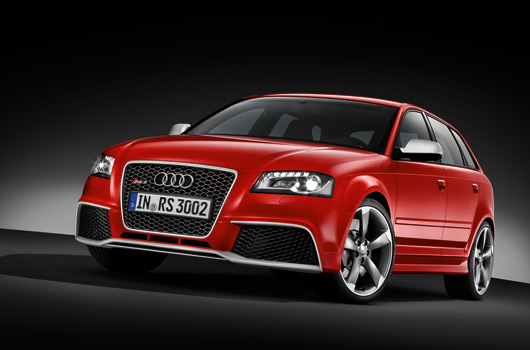
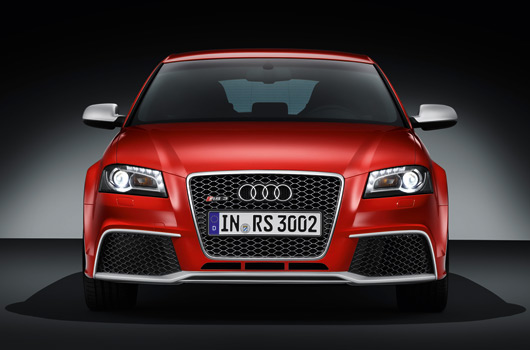
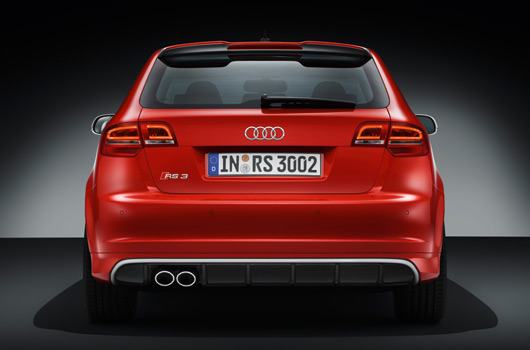
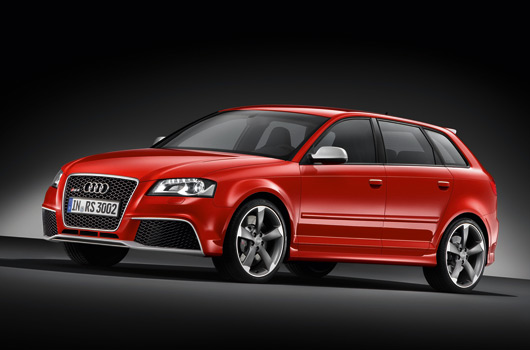
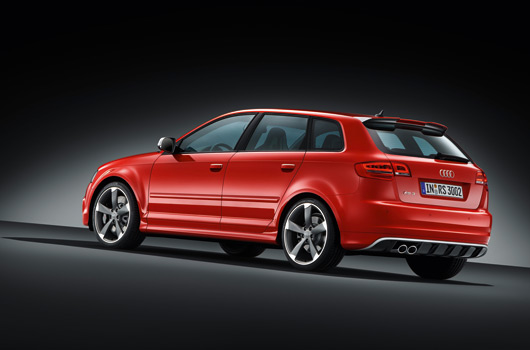
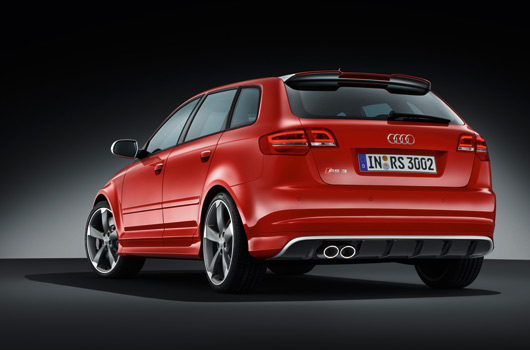
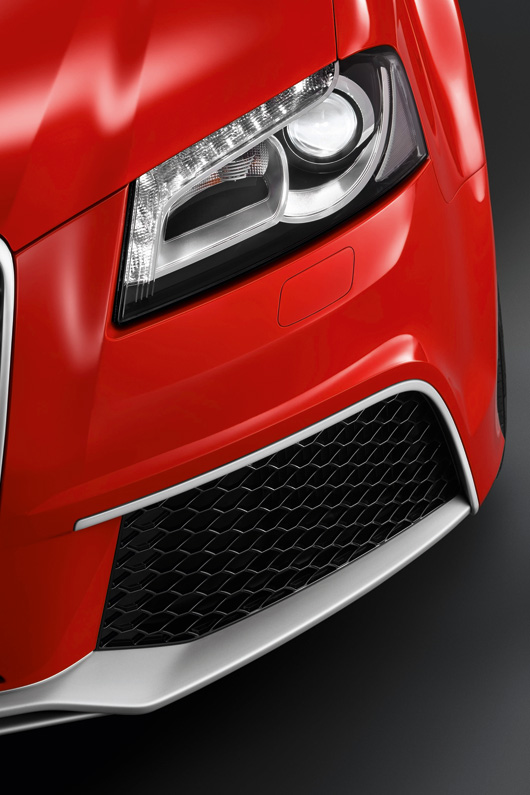
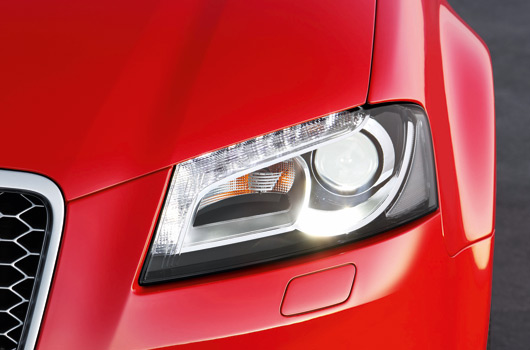
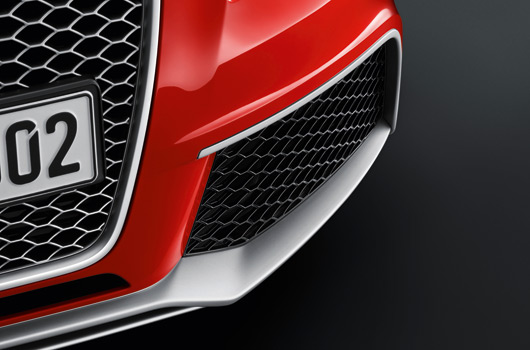
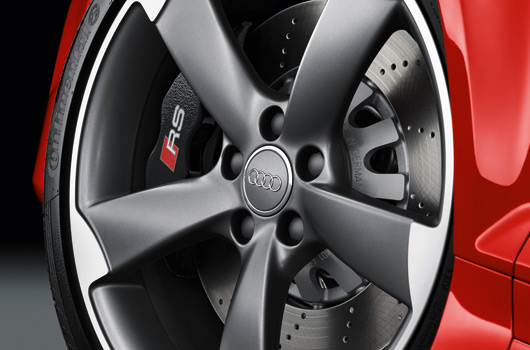
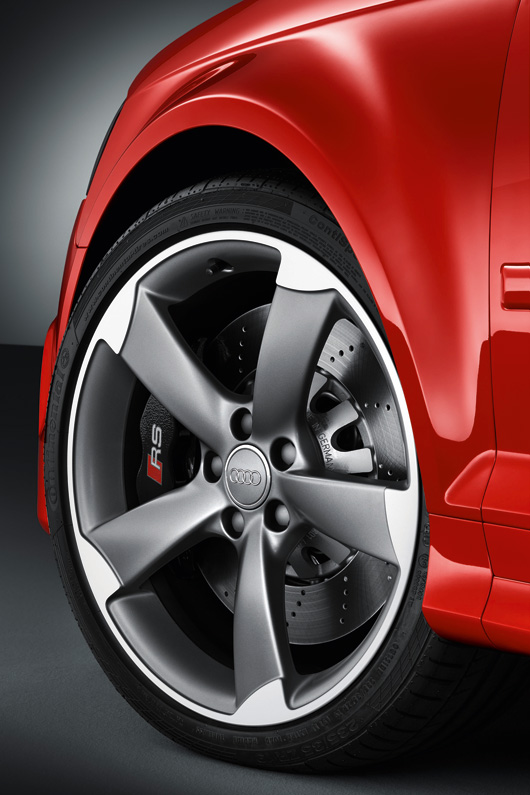
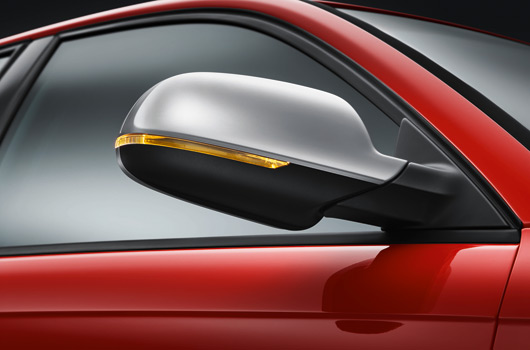
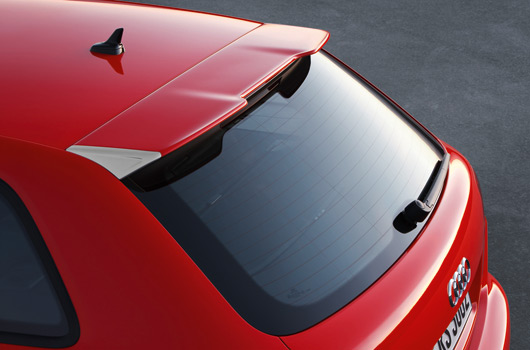
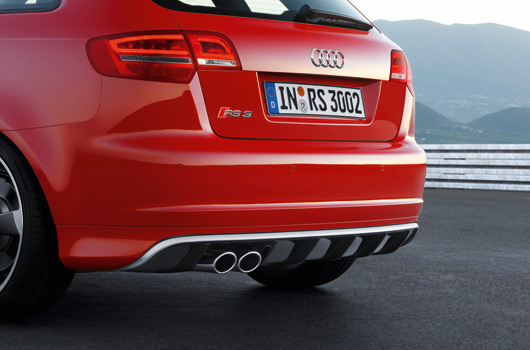
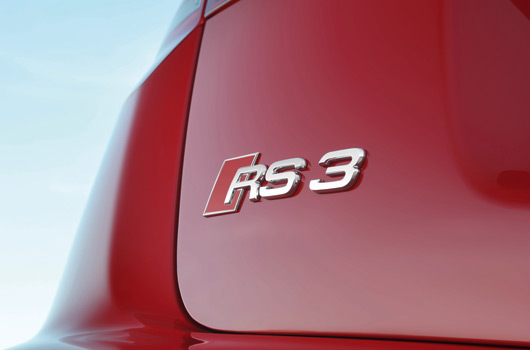
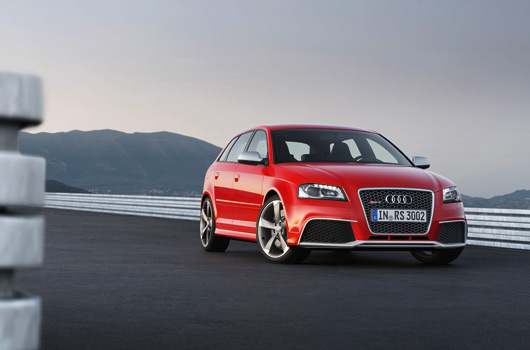
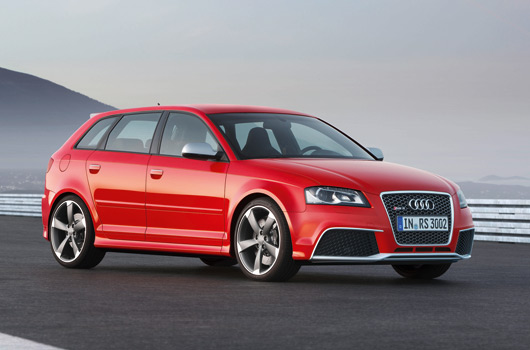
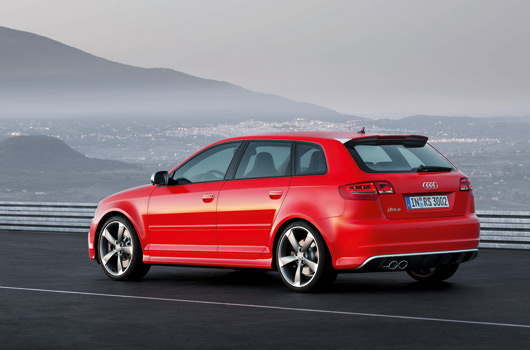
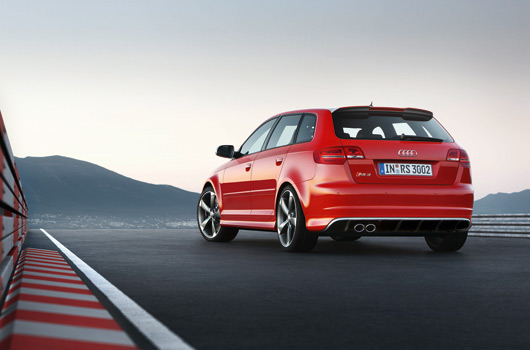
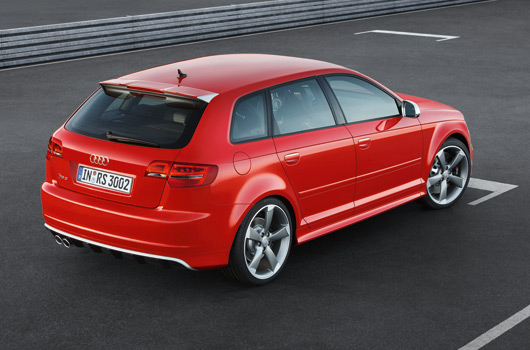
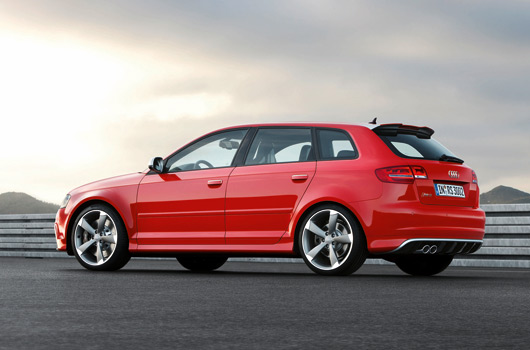
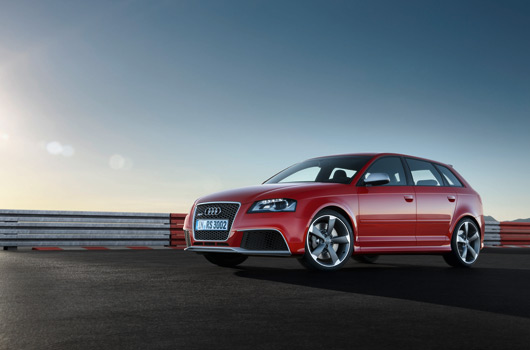
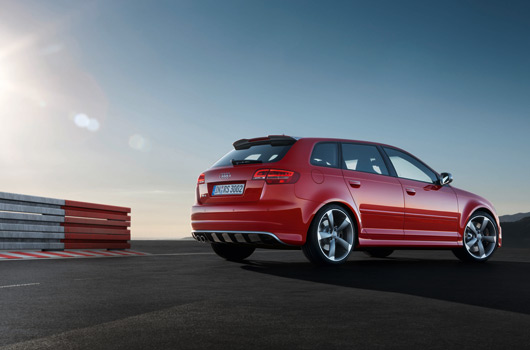
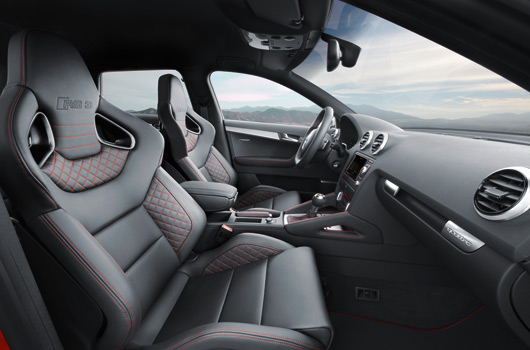
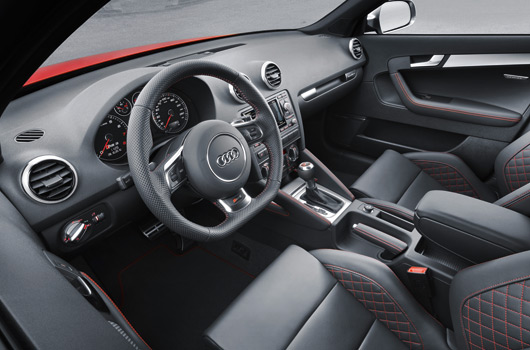
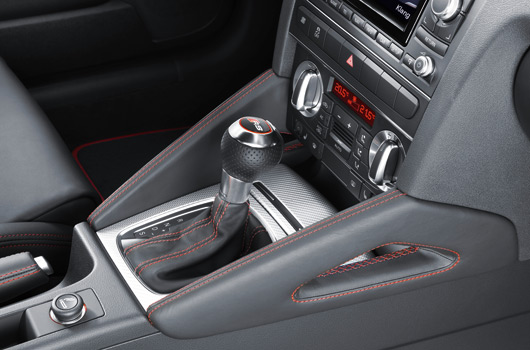
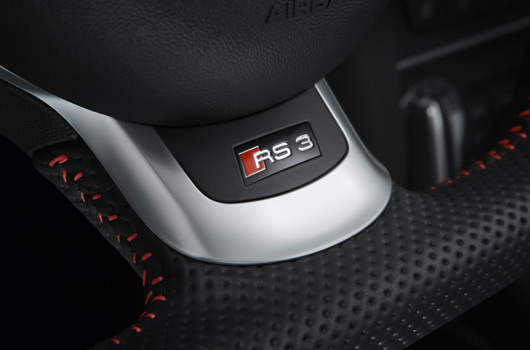
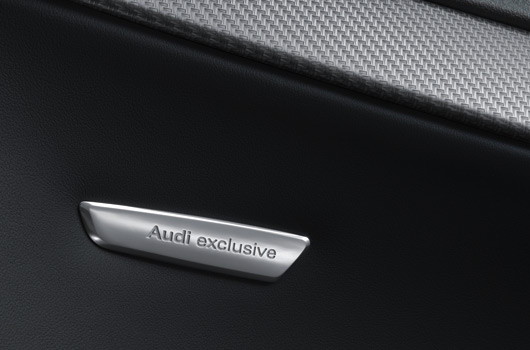
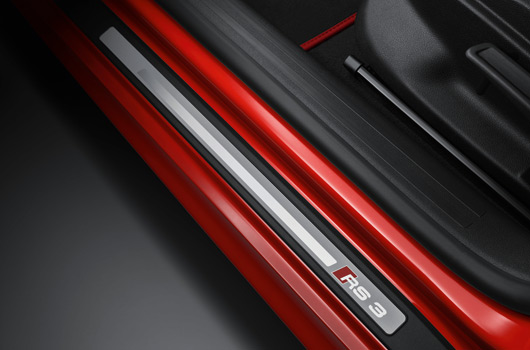
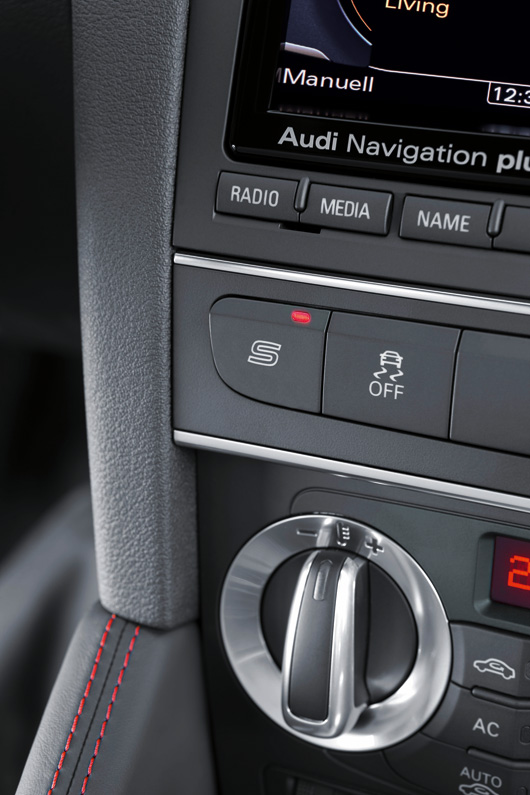
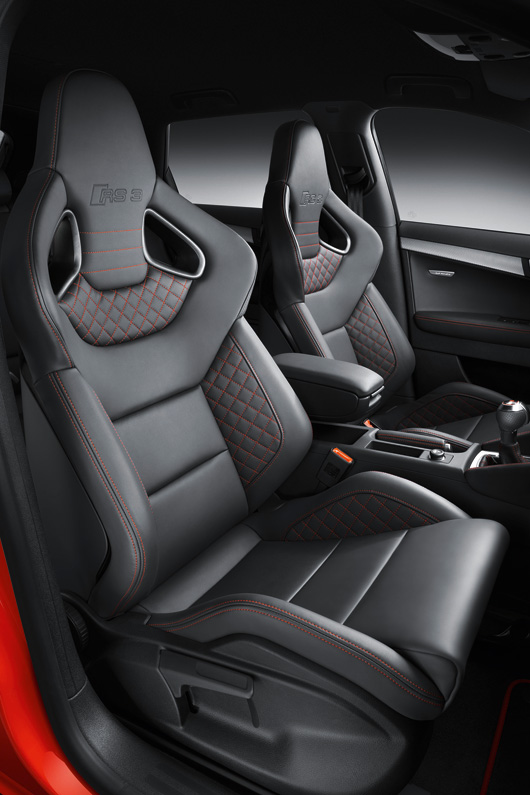
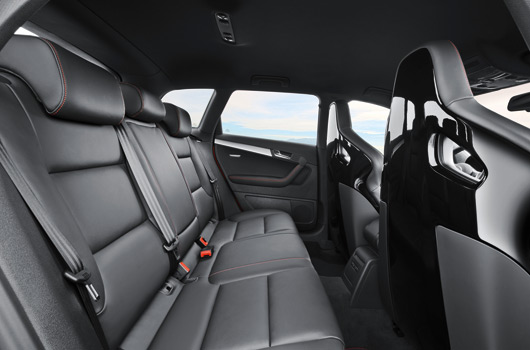
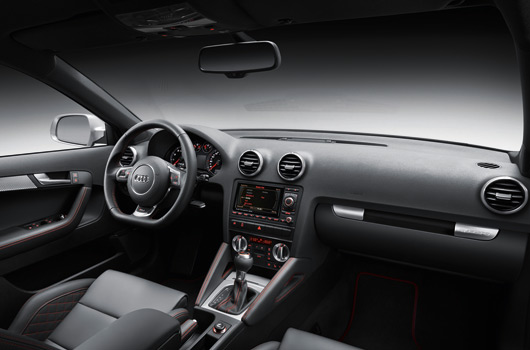
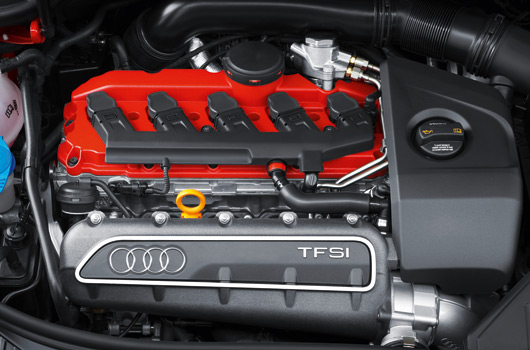
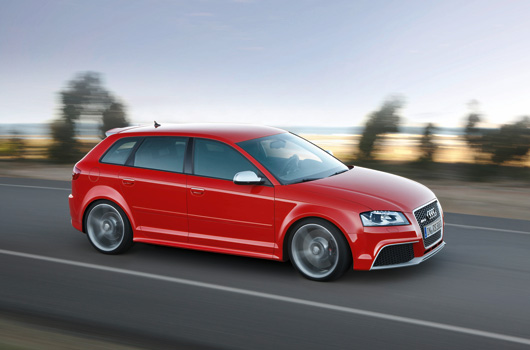
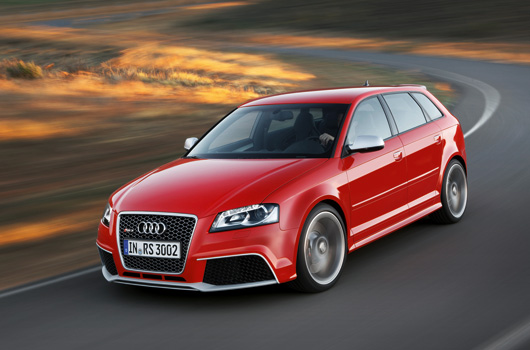
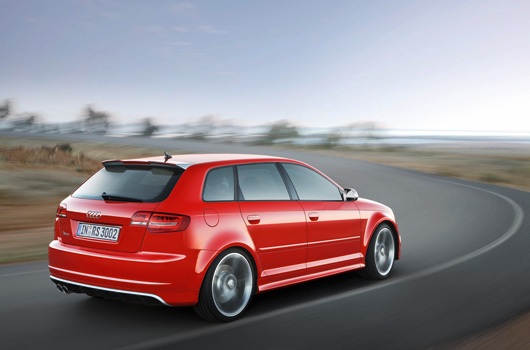
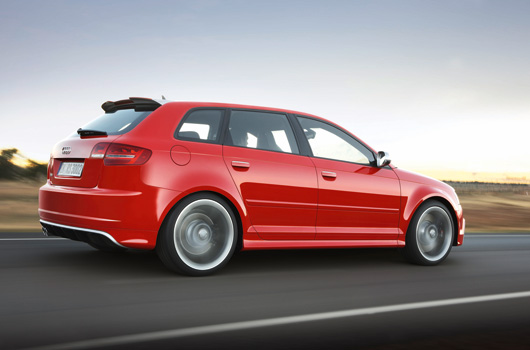
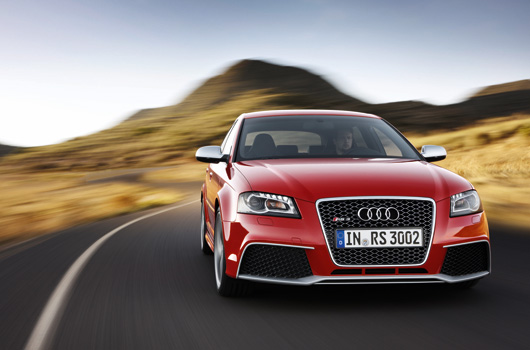
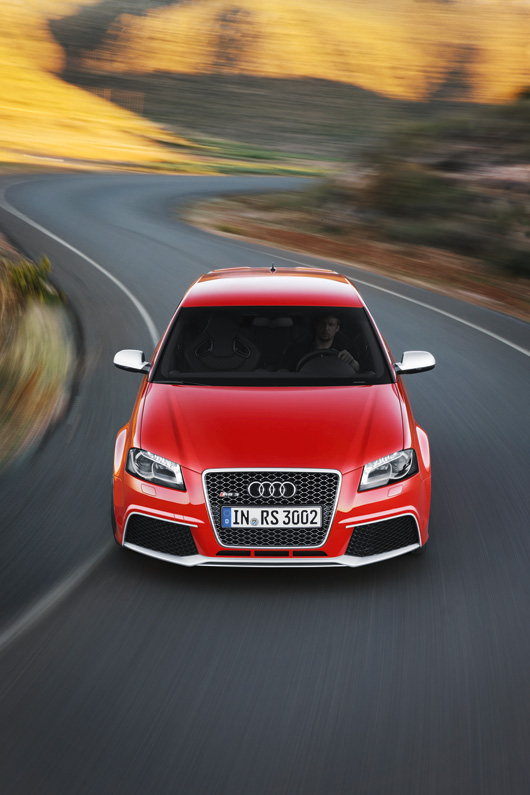
29 replies on “2011 Audi RS3 Sportback – official info & pics”
I’d tap that
No manual no care…..
I suppose Sportback is useful for dog owners and new parents (sigh!)
Golf R APR stage 1 + HPFP is far better value IMO
Where are the signature RS tailpipes?
And, no manual is a huge disappointment!
Do want.
Lima, delivery is said to be in early 2011? Is that for Europe or Oz? or both?
Apologies for the confusion; at the moment Audi Australia are being very coy…
AUSmotive: “I was just wondering if you can confirm this car will be coming to Australia, and if so when? Any idea on price range you can give me would be most welcome too.”
Audi Aus: “At this stage there is no information we can give you on this model regarding our market.”
If this car comes in at $90k as speculated by many, it would be tempting eventhough there are quite a few thing I don’t like about it.
Dammit! Thanks for verifying that Lima.
If it’s anywhere under $100k, I will take one, in any colour.
Audi build – tick
5 pot screamer – tick
Room for kids and dogs – tick
DSG for city crawl – tick
$100k to spend –
looks crap – x…
I reckon the silver accents on the front bumper/rear diffuser and spoiler look ugly! And that exhaust looks seriously weak!
[…] the release of official RS3 info from Audi earlier this week comes this series of wallpapers sourced from the Audi.de website. Shown […]
[…] Audi voiceover man is back; as lifeless as ever too. This time he is talking about the RS3 hyper hatch. There’s lots of facts and fugures, but, sadly, no driving footage. No 2.5 litre barking its […]
[…] cars are the models the 1 Series M Coupé has in its sights. A duo from Ingolstadt, Audi TT RS and RS3, a fighter from the land of the rising sun in the Nissan 370Z and, perhaps the toughest nut to […]
[…] last year we had a confidential whisper come our way that Audi’s stonking 250kW RS3 might not be coming to Australia. True to our source we have sat on that rumour, and unfortunately […]
[…] you’re a fan of the Audi RS3 you’ve probably seen the footage of the car mucking around on the snow and ice in Canada. If […]
[…] has just filed its first drive report on the 250kW five-pot Audi RS3. It’s the TT RS for the family buyer, with four doors and reasonable boot space. However, […]
[…] Audi TT RS has some very healthy numbers on its side. Let’s start with the 2.5 litre turbocharged inline […]
[…] first is its kerbweight. At 1495kg it’s actually not that bad. Around 80kg lighter than an Audi RS3 (not offered in Australia) and more than 180kg lighter than the M3. The 1M doesn’t feel heavy […]
[…] mag Auto Express has just put the 250kW all-wheel drive Audi RS3 with 7-speed S tronic on the drag strip against the 250kW rear-wheel drive BMW 1 Series M Coupé […]
[…] charming chrome-gated slots that were once so admired by so many. Lower down the food chain, the Audi RS3 is only offered with an ‘auto’ S tronic as […]
[…] Gear has put the 250kW/400Nm Audi RS3 and 250kW/400Nm BMW 1M on a racetrack and endeavoured to find out which is best. At the wheel are […]
[…] their wisdom Audi only ever made the RS3 in a five-door Sportback layout. Being lovers of three-door hatchbacks here at AUSmotive that made […]
[…] to Autocar, we can bring you an update on the car that Mercedes-Benz will aim squarely at the 250kW Audi RS3 and 235kW BMW […]
[…] his verdict on a classic Audi v BMW battle. The cars in question are the, now old-generation, RS3 and the new kid on the block, the […]
[…] will be liberate any more power from the 2.5 litre turbo five, or if they’ll maintain the current 250kW/450Nm? At the very least we think they should offer the same 265kW/465Nm found in the TT RS […]
[…] The Audi RS Q3 is now on Australian shores. It’s powered by a 228kW/420Nm version of the inline five cylinder engine found in the old RS3 Sportback. […]
[…] Audi UK has gone first with details of the new RS3 Sportback and it’s very good news too. Powered by the charismatic 2.5 litre inline five cylinder turbo engine the new RS3 pumps out 270kW (367PS) and 465Nm to all four wheels via its quattro all-wheel drive system. That’s a 20kW/15Nm increase over the previous-gen RS3. […]